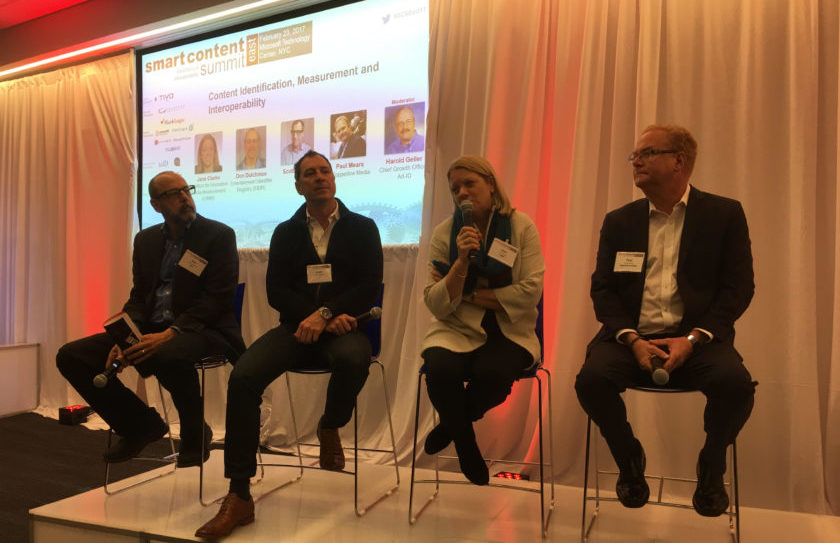Connections

TiVo Exec: Company’s Bullish on Open Standard Audio Watermark
Story Highlights
NEW YORK — An open standard audio watermark would be a positive for TiVo and the entertainment industry as a whole, according to Scott Maddux, VP of business development at TiVo.
A watermark standard “can be beneficial to TiVo because we have customers needing program verification and ad verification solutions. A standardized watermark solution would help TiVo bring those products and services to market,” he told the Media & Entertainment Services Alliance (MESA) Feb. 23, during the Smart Content Summit East at the Microsoft Technology Center in New York.
Therefore, he said, it was “big news” when it was announced Feb. 16 that Kantar Media’s audio watermarking technology for binding Ad-IDs to commercials and Entertainment ID Registry (EIDR) codes to programming content was selected for the next step in the standardization process for the Society of Motion Picture and Television Engineers’ (SMPTE) 24TB Open Binding of IDs (OBID) Drafting Group.
Earlier, during a panel discussion at the Summit on content identification, measurement and interoperability, Maddux said he was “excited about watermark standards” because, “for TiVo, that’s an enabler.” He explained: “We have a lot of customers looking for content identification/content tracking solutions and watermarks are a great way to do that. And, if it’s a standard, so much the better.”
But unique IDs are another important key to the equation. Maddux said: “The watermark is a great technology at its heart. But I think one of the next key questions is what’s in the payload? What information is contained within that watermark? And a unique ID is going to be one of those things.”
Maddux also agreed with Summit keynoter John Palfrey about the importance of interoperability.
Maddux stated: “From a commercial perspective, we’re not selling IDs; we’re selling products and services around those IDs.” In the end, he added: “It benefits all the layers in the industry, in the ecosystem, to [enable] standards around IDs, so we’ve been a strong supporter of EIDR for that reason.”
 These types of ID and watermark standards are needed more than ever now due to the “phenomenal fragmentation in the entertainment ecosystem, from creators to distributors to consumers to devices,” he went on to say.
These types of ID and watermark standards are needed more than ever now due to the “phenomenal fragmentation in the entertainment ecosystem, from creators to distributors to consumers to devices,” he went on to say.
Maddux pointed to what’s happening in short-form content for the broader “digital-first space,” where multichannel networks have proliferated, along with next-generation video studios and networks. As a result of that trend, “there’s a flood of content” and production values have grown “very, very quickly,” he said.
Maddux told MESA that TiVo knows how to manage data around film and television assets, books and games. He added: “We are now expanding our efforts around short-form and digital-first online video. There’s just an absolute explosion of content here. And these are the types of programming assets that are appealing to increasingly large millennial and Gen Z audiences making up half the population. We have to solve for that, and watermarks and ID standards are important tools that can help manage these emerging formats and catalogs.”
Also during the panel discussion, Harold Geller, chief growth officer at Ad-ID and conference chair, said advertisers were “increasingly looking for granularity” from audience measurement data.
That’s because “everything in television is becoming digital” and “digital is very granular,” according to Jane Clarke, CEO and managing director of the Coalition for Innovative Media Measurement (CIMM), whose members represent leading content owners, larger advertisers and media buying agencies. CIMM was part of the committee that recommended the selection of Kantar Media’s audio watermarking technology for binding Ad-IDs to commercials and EIDR codes to programming content. Ad-ID and EIDR were also members of the committee.
For every ad and every piece of content, “you can track it, attach information to it, evaluate it [and] analyze it, and so television has never been that way” until now, Clarke said.
In the past, it was all panel-based TV viewing measurement, she noted, pointing to combined Cablevision and Time Warner Cable return path data for the New York market that had showed more than 30% of viewing was of non-English channels not measured by Nielsen. As a result of issues like that, she said: “The old measurement methods of using panels to estimate viewing completely falls apart. It fell apart about 10 or 20 years ago for small, niche cable channels. But it completely falls apart when you have cross-platform behaviors” and somebody in the same house as another viewer is “watching some arcane piece of niche content and starting it on one platform and then finishing it on another platform.”
The focus on data’s importance throughout the M&E supply chain continues at Smart Content Summit West, being held Thursday, March 9 at the Luxe Sunset Boulevard Hotel in Los Angeles. For additional information and to register for the event, visit smartcontentsummit.com.









